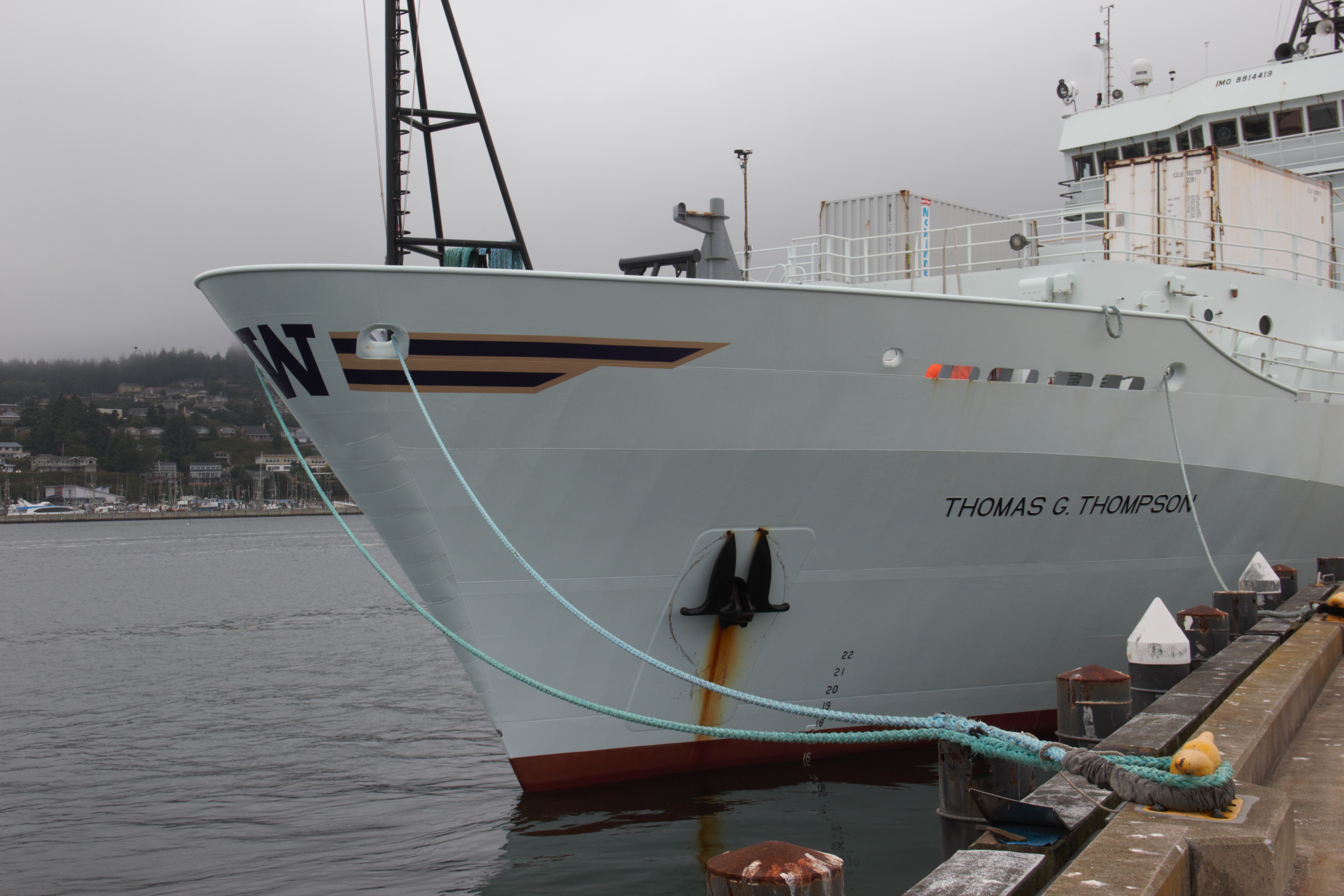Image Archive





























We saw this unusual orange-colored scale worm at the "Diva" vent while deploying a temperature and resistivity probe in a nearby chimney. Credit: UW/NSF-OOI/WHOI, Dive J2-1546, V23.

A giant rattail (over a meter long!) at the International District 2 junction box site. Credit: UW/NSF-OOI/WHOI, Dive J2-1544, V23.

A giant rattail came to visit the International District 2 junction box site. Credit: UW/NSF-OOI/WHOI, Dive J2-1544, V23.

About one hour of dive J2-1545 was spent finding the perfect location for the RAS/PPS fluid sampler vent cap. It had to be warmer than 20 ºC (so that we know that it's vent fluid) but not TOO hot, so that it wouldn't block the pump input with sulfide deposits. The still camera is positioned to monitor the site for the next year. Credit: UW/NSF-OOI/WHOI, Dive J2-1545, V23.

V23 Leg 3 VISIONS students and UW employees Andrew Paley, Mariela White, and Mitch Elend preparing to subsample the hydrothermal fluids collected by the RAS/PPS instrument during the 2022 deployment period. Credit: M. Vardaro, University of Washington.

Mystery! We encountered these green orbs on a few 2023 dives, mostly at 200 - 500 m depths, off the OR coast and at Axial Seamount. At first we thought they might be clogged larvacean houses, but they're all perfectly circular. Credit: A. Simmen, University of Washington.

A swordfish buzzed the ROV during deployment of dive J2-1545 at International District in Axial Caldera. Photo Credit: UW/NSF-OOI/WHOI, Dive J2-1545, V23.

A view of the Thompson from the dock. Credit: A. Jenkins, University of Washington; V23.

Figure 1

The Yaquina Bay bridge as seen during departure. Credit: A. Roberts, University of Washington, V23.

A Pacific sea nettle jellyfish swimming underneath the NOAA dock during the Thompson’s departure. Credit: A. Roberts, University of Washington, V23

Chlorophyll filtering setup – pipette for acetone on the left, and vacuum pump for samples on the right. Credit: A. Simmen, University of Washington; V23.

Mei and I putting our gloves on before starting to take samples from the niskin bottles on the CTD. Credit: A. Jenkins, University of Washington; V23.

Waves crashing above the starboard side of the R/V Thompson onto the deck in the morning. Credit: A. Simmen, University of Washington; V23.

From right to left – Patrik, Chris, Mei, Brian, and I out on deck by the CTD at night during the rough transit to Axial Seamount. Credit: A. Simmen, University of Washington; V23.

Leg 3 crew outside on the 03 deck of the Thompson at the beginning of the departure out to Axial Seamount. Credit: M. Elend, University of Washington; V23.

Topography interactive activity at OSU Hatfield Marine Science Center. Credit: A. Simmen, University of Washington; V23.

A wave breaking against the breakwater, taken while leaving port. Credit: Emily Pinneo, University of Washington, V23.

Sea lion resting on a marker buoy. Credit: Emily Pinneo, University of Washington, V23.

A pelican in flight off Newport. Credit: Emily Pinneo, University of Washington, V23.

Squat lobster, hagfish and soft corals at home on the Pinnacle. Credit: UW/NSF-OOI/WHOI; J2-1543; V23.

Soft corals of the genus Anthomastus cover the carbonate outcrops, west of the active seep site at Southern Hydrate Ridge. Credit: UW/NSF-OOI/WHOI; J2-1543; V23.

The rock I picked up while in control of Jason and its starboard manipulator arm. Credit: UW/NSF-OOI/WHOI; J2-1542; V23.

Adult Neptunea snails sit atop their egg-stalk structures, taken in 2014. Credit UW/NSF-OOI/CSSF; ROPOS dive 1758; V14

Neptunea egg stalks, tiny shrimp and a crab make use of the carbonate clasts. Credit: UW/NSF-OOI/WHOI; J2-1542; V23.

Unattended Neptunea egg stalks on carbonate cobbles cover the seafloor just south of an active seepage site. Credit: UW/NSF-OOI/WHOI; J2-1542; V23.

A hagfish and a rockfish close together in a sedimented area of the Pinnacle. Credit: UW/NSF-OOI/WHOI; J2-1543; V23.

A bubblegum coral stands proud atop the carbonate pinnacle. Credit: UW/NSF-OOI/WHOI; J2-1543.
- Anemone
- Animal
- Arthropod
- ASHES
- Axial
- Axial Base
- Axial Biology
- Axial Caldera
- Bacteria
- Basalt Lava
- BEP
- Biofouling
- biolgoy
- Biology
- Camds
- Camera
- Camhd
- Central Caldera
- Ciliates
- Cnidaria
- Coastal Biology
- Crab
- Deep Profiler Mooring
- Dive Highlights
- Eastern Caldera
- Echinoderms
- Endurance Array
- Engineering Team
- ENLIGHTEN 10
- Exploratorium
- Fish
- Geology
- HD Camera
- HPIES
- Hydrate Ridge
- Hydrates
- Hydrophone
- Hydrothermal Vents
- Illustration
- Inshore 80 Meters
- Instrument
- International District
- J-BOX
- Jason
- Jellyfish
- Junction Box
- K12
- Lava
- Mollusk
- Moorings
- Nodes
- Nudibranch
- Octopus
- OOI
- Oregon Offshore
- Oregon Offshore 600 m
- Oregon Shelf
- Oregon Slope Base
- People
- PN1B
- PN1D
- Polychaetes
- PPSDN
- Primary Node
- RASFL
- ROCLS
- ROPOS
- ROPOS Dives
- ROV Team
- RV Revelle
- RV Sikuliaq
- RV Thompson
- Salp
- Sample
- SC13
- Science Team
- Sea Cucumber
- Sea Star
- Sea Urchin
- Seafloor
- Seismometer
- Sensors
- Shallow Profiler Mooring
- Shark
- Shipboard
- Shore Station
- Slope Base
- Smoker
- Soft Coral
- Southern Hydrate Ridge
- Sponge
- Squid
- Students
- Students & Guest Participants
- Tmpsf
- Tubeworms
- VISIONS 11 Leg 1
- VISIONS 11 Leg 2
- VISIONS 11 Viewers
- VISIONS 13
- VISIONS 14
- VISIONS 15
- VISIONS 16
- VISIONS 17
- VISIONS 18
- VISIONS 20
- VISIONS 22
- VISIONS 23
- Visualization
